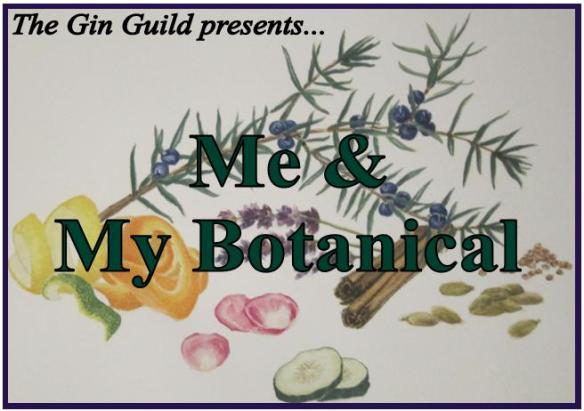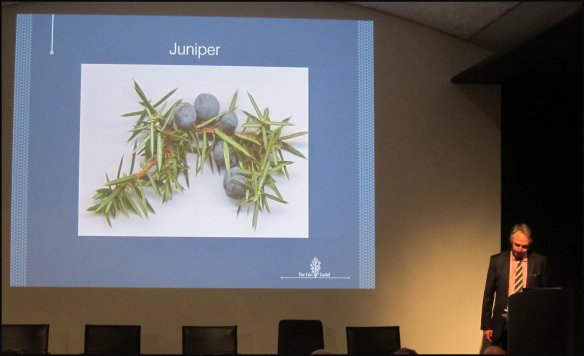

A lot has changed since Mrs. B & I first made our way up to London for the first ever Juniper Society (the launch of SW4 Gin) in July 2010; since then, we have written a plethora of articles, contributed to trade magazines and I’m now writer-in-residence for Graphic Bar, the very location of that first meeting.

An artist’s impressionof the Professor – sketched on the back of an envelope.
As such, it was with considerable anticipation that I travelled up to London for the 2nd birthday party to celebrate this special group of people. Of course, if you are looking for special and unique products, then look no further than Master of Malt, the drinks and spirits shop that are now pioneering a new wave of drink innovation with their in-house products. The revolution is spearheaded by Professor Cornelius Ampleforth, whose crazy concoctions we have written about on a number of occasions.
Today’s focus is on Master of Malt’s new range of Single Estate Gins, which are the brainchild of Ben Ellefsen, their Sales Director (I like to think of him more as Head of Innovation). Whilst he was making his Bathtub Gin, he uncovered inconsistencies in the batches of juniper that he was using, even though his supplier insisted they were from the same country. Sadly, they could not be more precise regarding the exact origin of the berries and, thus, a project was born.

Even Holmes struggles with this mystery bottle.
Ben set out to source quality juniper berries that could be traced back to a much narrower area. A bounty was placed on such juniper and advertised on the Master of Malt website. After a lot of leg work from Ben and his team, the first four Single Estate Gins are finally ready.
Each bottle contains 700ml of Juniper Spirit (or single botanical gin, if you will); the juniper of which all comes from a single geographical source. The actual species of the berries (Juniperus Communis) is constant throughout. Each bottle is also accompanied by a small 10ml vial, but I’ll write more on that in part 2 of this article. For now, here are my tasting notes for the four Single Estate Gins.
1) BULGARIA – VELIKI PRESLAV
 i) On its own
i) On its own
Nose: Full and leafy, with fresh, ripe juniper and some citrus. This is bursting with character and very inviting.
Taste: There’s an initial smoothness with a touch of citrus, followed by sweetness in the middle. This then moves towards an earthy bitterness, including dark chocolate on the finish, as well as a slight pepperiness.
ii) Gin & Tonic
Crisp, fresh and leafy green. There’s a distinctive taste of fresh juniper berries, along with a dash of citrus and a touch of lavender. This could probably do with a garnish, just to perfect it.
iii) Martini
Creamy, but with the juniper family’s recognisable leafy-green flavours. It’s definitely dry, but manages to retain its creaminess; very distinctive.
iv) Negroni
A relatively sweet drink; a touch syrupy, with a pronounced bitter finish. Good level of dryness. Classic in style, but perhaps a little lacking in depth. There’s a coffee or chocolate-like bitterness towards the end.
2) NETHERLANDS – MEPPEL
 i) On its own
i) On its own
Nose: Deep piney and resinous juniper notes, with a slight nuttiness. A mix of savoury, citrus and floral notes gives this a full and very complex flavour, especially given that it is only one botanical.
Taste: Silky to begin; a little creamy, quite thick and rich. There is a lot going on, but the balance of the various notes is good. Coriander pops up halfway through. This is easily as complex as many other gins, which, given that it’s all from the juniper, is incredible, really.
ii) Gin &Tonic
Quite a citrusy Gin & Tonic with a touch of hazelnut. Very fresh and deliciously crisp. This is a drink that easily competes with the best of them – rather superb!
iii) Martini
A well-rounded Martini: clean and crisp, with notable some herbal notes in addition to those of the juniper. A hint of dry bitterness on the finish. This is a very Classic Martini, with a long fresh finish. Very good.
iv) Negroni
Smooth and fruity with a good bittersweet balance, I think this is quite accessible. Fans of Negronis will be content and it may even convert some very reluctant drinkers of Campari.
It’s smoothness makes it very easy to drink, but it’s still packed full of flavour.
3) ALBANIA – VALBONE
 i) On its own
i) On its own
Nose: More subtle than the previous two; the juniper is lighter, but still clearly there and accompanied by floral notes, such as violet. The whole spirit seems rather confectionary, with a biscuity spiciness (maybe cayenne pepper) and hints of sweet liquorice and coconut.
Taste: Soft and smooth. There’s some juniper, but the spirit seems sweeter than the previous two, although obviously not sugary. The sweetness is a botanical one and actually reminded some of the Jolly Gin Fellows of varieties of Old Tom Gin; perhaps this gin would make a good base for one? Sweet citrus and liquorice root on the finish.
ii) Gin &Tonic
A real departure from the previous two, showing how much of a difference the berries make. This drink is lighter and cleaner, although, as such, it doesn’t stand up so well to the tonic water. Overall, this is still a pleasant drink with a dry, juniper finish.
iii) Martini
A silky Martini, although the juniper seems a lot less prominent – it’s almost as if this is 50/50 mix of a gin and vodka Martini. Subtle and a touch on the sweet side (that liquorice again!), but by no means a bad drink.
iv) Negroni
This starts with a gentle, earthy bitterness. It’s not very sweet, but there’s a good dose of herbal flavours, along with some deep, spicy notes. On reflection, this is quite a gentle Negroni that is much improved with a slice of orange.
4) ITALY – AREZZO
 i) On its own
i) On its own
Nose: A clean nose of dry, zesty juniper, like pine needles; reminds me of a forest after its been raining.
Taste: The green pine continues to remind me of a forest. There is also a hint of vanilla, a creamy smoothness and a touch of lemon peel.
ii) Gin &Tonic
This was a rather a powerful Gin & Tonic, so if you like your drinks to be made with a powerful gin, then this is for you! Definitely a no-nonsense drink: juniper, quinine, and bubbles, making for great refreshment.
iii) Martini
A very clean and ultra-smooth Martini that adds a little warmth to the stomach once you have swallowed it. This is a drink that really makes an impact and, in my opinion, explains why Martinis are sometimes said to remind people of the purity of diamonds.
iv) Negroni
Quite a sweet Negroni, but with some bitterness at the end. Quite good, but maybe a touch too syrupy. A zesty garnish should perks things up, though.
There are also plans to add a fifth and sixth locational variety (Macedonia and Kosovo), but, for the moment, this ends Part One; Part Two can be found here.
Master of Malt Origin Gins are available at £34.95 a bottle (71cl) from their website.













































